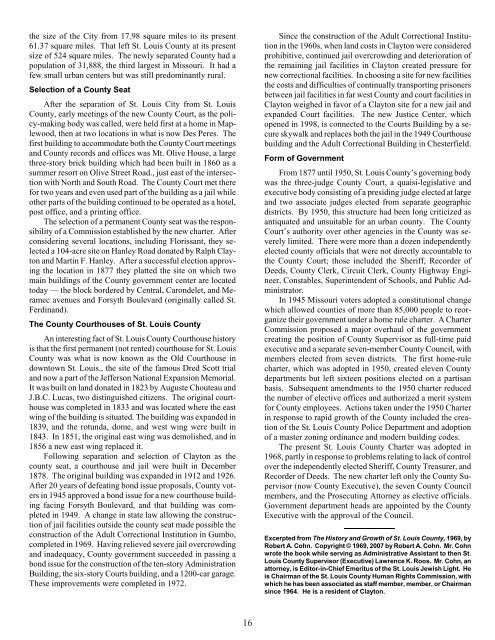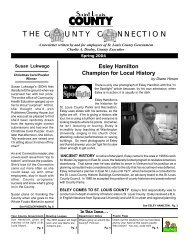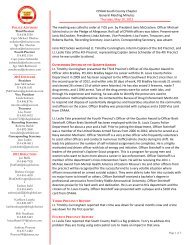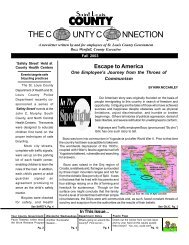2006 - St. Louis County
2006 - St. Louis County
2006 - St. Louis County
You also want an ePaper? Increase the reach of your titles
YUMPU automatically turns print PDFs into web optimized ePapers that Google loves.
the size of the City from 17.98 square miles to its present61.37 square miles. That left <strong>St</strong>. <strong>Louis</strong> <strong>County</strong> at its presentsize of 524 square miles. The newly separated <strong>County</strong> had apopulation of 31,888, the third largest in Missouri. It had afew small urban centers but was still predominantly rural.Selection of a <strong>County</strong> SeatAfter the separation of <strong>St</strong>. <strong>Louis</strong> City from <strong>St</strong>. <strong>Louis</strong><strong>County</strong>, early meetings of the new <strong>County</strong> Court, as the policy-makingbody was called, were held first at a home in Maplewood,then at two locations in what is now Des Peres. Thefirst building to accommodate both the <strong>County</strong> Court meetingsand <strong>County</strong> records and offices was Mt. Olive House, a largethree-story brick building which had been built in 1860 as asummer resort on Olive <strong>St</strong>reet Road., just east of the intersectionwith North and South Road. The <strong>County</strong> Court met therefor two years and even used part of the building as a jail whileother parts of the building continued to be operated as a hotel,post office, and a printing office.The selection of a permanent <strong>County</strong> seat was the responsibilityof a Commission established by the new charter. Afterconsidering several locations, including Florissant, they selecteda 104-acre site on Hanley Road donated by Ralph Claytonand Martin F. Hanley. After a successful election approvingthe location in 1877 they platted the site on which twomain buildings of the <strong>County</strong> government center are locatedtoday — the block bordered by Central, Carondelet, and Meramecavenues and Forsyth Boulevard (originally called <strong>St</strong>.Ferdinand).The <strong>County</strong> Courthouses of <strong>St</strong>. <strong>Louis</strong> <strong>County</strong>An interesting fact of <strong>St</strong>. <strong>Louis</strong> <strong>County</strong> Courthouse historyis that the first permanent (not rented) courthouse for <strong>St</strong>. <strong>Louis</strong><strong>County</strong> was what is now known as the Old Courthouse indowntown <strong>St</strong>. <strong>Louis</strong>., the site of the famous Dred Scott trialand now a part of the Jefferson National Expansion Memorial.It was built on land donated in 1823 by Auguste Chouteau andJ.B.C. Lucas, two distinguished citizens. The original courthousewas completed in 1833 and was located where the eastwing of the building is situated. The building was expanded in1839, and the rotunda, dome, and west wing were built in1843. In 1851, the original east wing was demolished, and in1856 a new east wing replaced it.Following separation and selection of Clayton as thecounty seat, a courthouse and jail were built in December1878. The original building was expanded in 1912 and 1926.After 20 years of defeating bond issue proposals, <strong>County</strong> votersin 1945 approved a bond issue for a new courthouse buildingfacing Forsyth Boulevard, and that building was completedin 1949. A change in state law allowing the constructionof jail facilities outside the county seat made possible theconstruction of the Adult Correctional Institution in Gumbo,completed in 1969. Having relieved severe jail overcrowdingand inadequacy, <strong>County</strong> government succeeded in passing abond issue for the construction of the ten-story AdministrationBuilding, the six-story Courts building, and a 1200-car garage.These improvements were completed in 1972.16Since the construction of the Adult Correctional Institutionin the 1960s, when land costs in Clayton were consideredprohibitive, continued jail overcrowding and deterioration ofthe remaining jail facilities in Clayton created pressure fornew correctional facilities. In choosing a site for new facilitiesthe costs and difficulties of continually transporting prisonersbetween jail facilities in far west <strong>County</strong> and court facilities inClayton weighed in favor of a Clayton site for a new jail andexpanded Court facilities. The new Justice Center, whichopened in 1998, is connected to the Courts Building by a secureskywalk and replaces both the jail in the 1949 Courthousebuilding and the Adult Correctional Building in Chesterfield.Form of GovernmentFrom 1877 until 1950, <strong>St</strong>. <strong>Louis</strong> <strong>County</strong>’s governing bodywas the three-judge <strong>County</strong> Court, a quaisi-legislative andexecutive body consisting of a presiding judge elected at largeand two associate judges elected from separate geographicdistricts. By 1950, this structure had been long criticized asantiquated and unsuitable for an urban county. The <strong>County</strong>Court’s authority over other agencies in the <strong>County</strong> was severelylimited. There were more than a dozen independentlyelected county officials that were not directly accountable tothe <strong>County</strong> Court; those included the Sheriff, Recorder ofDeeds, <strong>County</strong> Clerk, Circuit Clerk, <strong>County</strong> Highway Engineer,Constables, Superintendent of Schools, and Public Administrator.In 1945 Missouri voters adopted a constitutional changewhich allowed counties of more than 85,000 people to reorganizetheir government under a home rule charter. A CharterCommission proposed a major overhaul of the governmentcreating the position of <strong>County</strong> Supervisor as full-time paidexecutive and a separate seven-member <strong>County</strong> Council, withmembers elected from seven districts. The first home-rulecharter, which was adopted in 1950, created eleven <strong>County</strong>departments but left sixteen positions elected on a partisanbasis. Subsequent amendments to the 1950 charter reducedthe number of elective offices and authorized a merit systemfor <strong>County</strong> employees. Actions taken under the 1950 Charterin response to rapid growth of the <strong>County</strong> included the creationof the <strong>St</strong>. <strong>Louis</strong> <strong>County</strong> Police Department and adoptionof a master zoning ordinance and modern building codes.The present <strong>St</strong>. <strong>Louis</strong> <strong>County</strong> Charter was adopted in1968, partly in response to problems relating to lack of controlover the independently elected Sheriff, <strong>County</strong> Treasurer, andRecorder of Deeds. The new charter left only the <strong>County</strong> Supervisor(now <strong>County</strong> Executive), the seven <strong>County</strong> Councilmembers, and the Prosecuting Attorney as elective officials.Government department heads are appointed by the <strong>County</strong>Executive with the approval of the Council.Excerpted from The History and Growth of <strong>St</strong>. <strong>Louis</strong> <strong>County</strong>, 1969, byRobert A. Cohn. Copyright © 1969, 2007 by Robert A. Cohn. Mr. Cohnwrote the book while serving as Administrative Assistant to then <strong>St</strong>.<strong>Louis</strong> <strong>County</strong> Supervisor (Executive) Lawrence K. Roos. Mr. Cohn, anattorney, is Editor-in-Chief Emeritus of the <strong>St</strong>. <strong>Louis</strong> Jewish Light. Heis Chairman of the <strong>St</strong>. <strong>Louis</strong> <strong>County</strong> Human Rights Commission, withwhich he has been associated as staff member, member, or Chairmansince 1964. He is a resident of Clayton.16
















